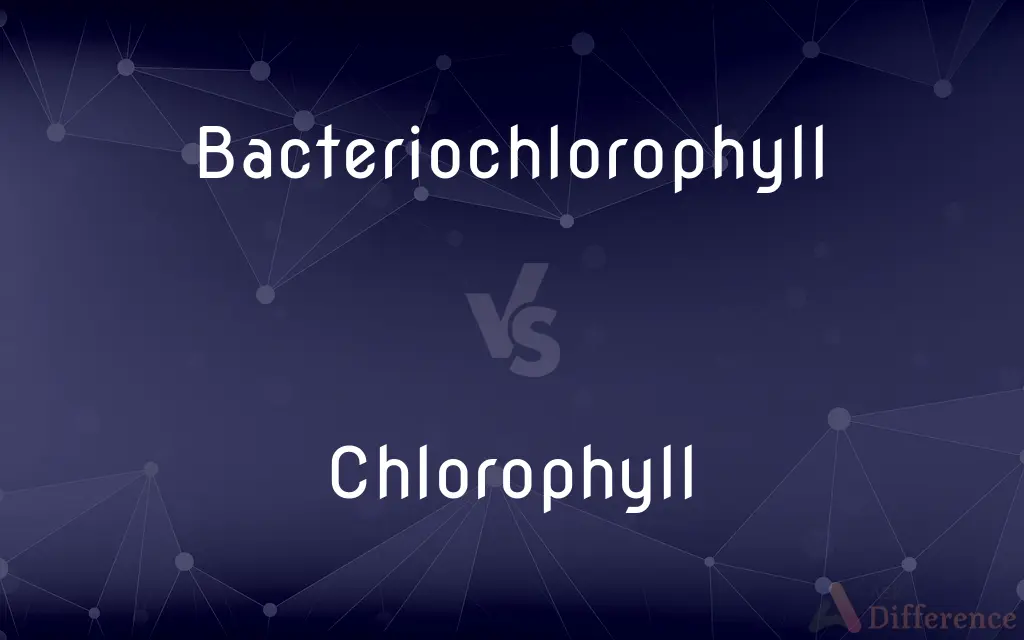Bacteriochlorophyll vs. Chlorophyll — What's the Difference?
Edited by Tayyaba Rehman — By Fiza Rafique — Updated on September 28, 2023
Bacteriochlorophyll is found in photosynthetic bacteria and absorbs different light wavelengths than chlorophyll, which is in plants.

Difference Between Bacteriochlorophyll and Chlorophyll
Table of Contents
ADVERTISEMENT
Key Differences
Bacteriochlorophyll and chlorophyll are both pigments that play pivotal roles in photosynthesis. While chlorophyll is primarily found in plants, algae, and cyanobacteria, bacteriochlorophyll is specific to certain photosynthetic bacteria.
These pigments differ in their chemical structure. Bacteriochlorophyll has a structure tailored to its microbial environment, while chlorophyll is designed for the cellular environment of plants and algae.
Bacteriochlorophyll and chlorophyll also absorb light at different wavelengths. This means they are sensitive to different parts of the light spectrum, which is crucial for their respective organisms' energy absorption processes.
The significance of bacteriochlorophyll lies in its ability to facilitate photosynthesis in environments where light may be limited or of specific wavelengths. In contrast, chlorophyll allows plants and algae to harness energy primarily from visible sunlight.
Despite their differences, both bacteriochlorophyll and chlorophyll underscore the versatility and adaptability of photosynthetic organisms across different environments and evolutionary histories.
ADVERTISEMENT
Comparison Chart
Found In
Specific photosynthetic bacteria
Plants, algae, and cyanobacteria
Chemical Structure
Different from chlorophyll
Unique to plants and algae
Light Absorption
Absorbs different wavelengths than chlorophyll
Absorbs mainly visible sunlight
Importance
Facilitates photosynthesis in specific environments
Drives photosynthesis in most green plants and algae
Evolutionary Context
Adapted for microbial environments
Key in the evolution and success of green organisms
Compare with Definitions
Bacteriochlorophyll
A photosynthetic pigment found in certain bacteria.
The green hue in purple bacteria comes from bacteriochlorophyll.
Chlorophyll
A green pigment in plants essential for photosynthesis.
The leaves are green because of chlorophyll.
Bacteriochlorophyll
A molecule aiding photosynthesis in specific microbes.
Scientists studied bacteriochlorophyll to understand bacterial energy processes.
Chlorophyll
The molecule that helps plants capture sunlight for energy.
Chlorophyll is crucial for plant growth and health.
Bacteriochlorophyll
A pigment helping bacteria convert light to energy.
The presence of bacteriochlorophyll distinguishes photosynthetic bacteria.
Chlorophyll
An essential component in turning light energy into chemical energy in plants.
Plants rely on chlorophyll to produce their food.
Bacteriochlorophyll
The counterpart of chlorophyll in certain bacteria.
Bacteriochlorophyll gives green sulfur bacteria their color.
Chlorophyll
A compound giving plants their green color and aiding energy conversion.
Without chlorophyll, plants couldn't perform photosynthesis.
Bacteriochlorophyll
The chlorophyll analog in photosynthetic bacteria.
Research on bacteriochlorophyll can reveal early photosynthesis forms.
Chlorophyll
The primary pigment responsible for absorbing light in plants.
Chlorophyll absorbs the sunlight, powering the plant's energy processes.
Bacteriochlorophyll
Bacteriochlorophylls (BChl) are photosynthetic pigments that occur in various phototrophic bacteria. They were discovered by C. B. van Niel in 1932.
Chlorophyll
Chlorophyll (also chlorophyl) is any of several related green pigments found in the mesosomes of cyanobacteria and in the chloroplasts of algae and plants. Its name is derived from the Greek words χλωρός, khloros ("pale green") and φύλλον, phyllon ("leaf").
Bacteriochlorophyll
Any of a group of pigments, especially one having the formula C55H74MgN4O6, that absorb light energy used in photosynthesis and that are found in photosynthetic bacteria that do not produce oxygen as a byproduct of photosynthesis.
Chlorophyll
A waxy blue-black microcrystalline green-plant pigment, C55H72MgN4O5, with a characteristic blue-green alcohol solution. Also called chlorophyll a.
Bacteriochlorophyll
(biology) A photosynthetic pigment occurring in various phototrophic bacteria, related to the chlorophylls.
Chlorophyll
A similar green-plant pigment, C55H70MgN4O6, having a brilliant green alcohol solution. Also called chlorophyll b.
Bacteriochlorophyll
A substance in photosensitive bacteria that is related to but different from chlorophyll of higher plants
Chlorophyll
(biochemistry) Any of a group of green pigments that are found in the chloroplasts of plants and in other photosynthetic organisms such as cyanobacteria.
Chlorophyll
Literally, leaf green; a green granular matter formed in the cells of the leaves (and other parts exposed to light) of plants, to which they owe their green color, and through which all ordinary assimilation of plant food takes place. Similar chlorophyll granules have been found in the tissues of the lower animals.
Chlorophyll
Any of a group of green pigments found in photosynthetic organisms. Chlorophyll a and chlorophyll b are found in higher plants and green algae; chlorophyll c is found in certain types of marine algae. Chemically, it has a porphyrin ring with a magnesium ion bound to the four central nitrogens, and has a phytyl side chain. It is essential for photosynthesis in most plants. Chlorophyll a has formula C55H72N4O5Mg.
Chlorophyll
Any of a group of green pigments found in photosynthetic organisms
Common Curiosities
Is chlorophyll only found in plants?
Chlorophyll is mainly in plants, algae, and cyanobacteria.
What is bacteriochlorophyll?
Bacteriochlorophyll is a pigment found in certain photosynthetic bacteria.
What wavelengths of light does chlorophyll absorb?
Chlorophyll primarily absorbs visible sunlight.
Why is chlorophyll green?
Chlorophyll reflects green light, which gives plants their green color.
Are there different types of bacteriochlorophyll?
Yes, there are several types of bacteriochlorophyll, each with specific absorption properties.
Where is bacteriochlorophyll specifically located?
Bacteriochlorophyll is in specific photosynthetic bacteria, like purple and green sulfur bacteria.
How does bacteriochlorophyll differ from chlorophyll chemically?
Bacteriochlorophyll has a different chemical structure tailored for bacterial environments.
Can bacteriochlorophyll be found in plants?
No, bacteriochlorophyll is specific to certain bacteria.
Do all plants have chlorophyll?
Most plants have chlorophyll, which is essential for photosynthesis.
What role does chlorophyll play in food chains?
Chlorophyll in plants is the base of many food chains, converting sunlight into energy.
Can bacteriochlorophyll and chlorophyll coexist in the same organism?
No, typically they are found in distinct organisms with specific photosynthetic processes.
What is the primary function of chlorophyll?
Chlorophyll captures sunlight for photosynthesis in plants.
Does chlorophyll exist in non-green plants?
Yes, but in lower quantities, often overshadowed by other pigments.
Is bacteriochlorophyll as studied as chlorophyll?
While chlorophyll has been extensively studied due to its prevalence, bacteriochlorophyll is also a significant research area, especially in understanding early photosynthetic processes.
Why is bacteriochlorophyll important for certain bacteria?
Bacteriochlorophyll allows these bacteria to perform photosynthesis in specific environments.
Share Your Discovery

Previous Comparison
Overalls vs. Bib
Next Comparison
Newt vs. LizardAuthor Spotlight
Written by
Fiza RafiqueFiza Rafique is a skilled content writer at AskDifference.com, where she meticulously refines and enhances written pieces. Drawing from her vast editorial expertise, Fiza ensures clarity, accuracy, and precision in every article. Passionate about language, she continually seeks to elevate the quality of content for readers worldwide.
Edited by
Tayyaba RehmanTayyaba Rehman is a distinguished writer, currently serving as a primary contributor to askdifference.com. As a researcher in semantics and etymology, Tayyaba's passion for the complexity of languages and their distinctions has found a perfect home on the platform. Tayyaba delves into the intricacies of language, distinguishing between commonly confused words and phrases, thereby providing clarity for readers worldwide.
















































